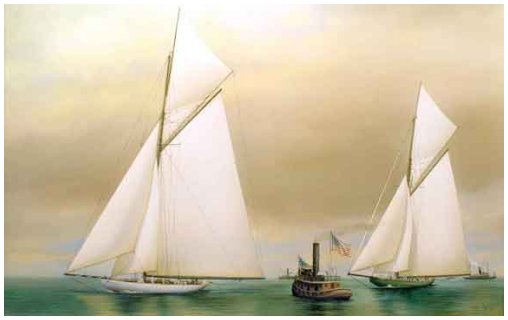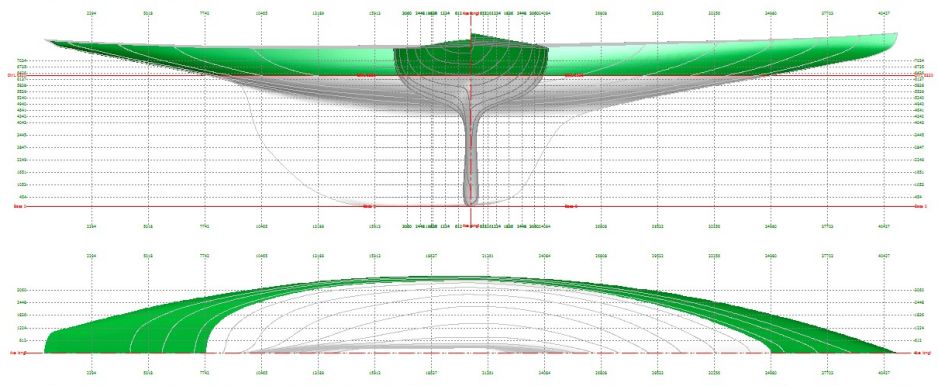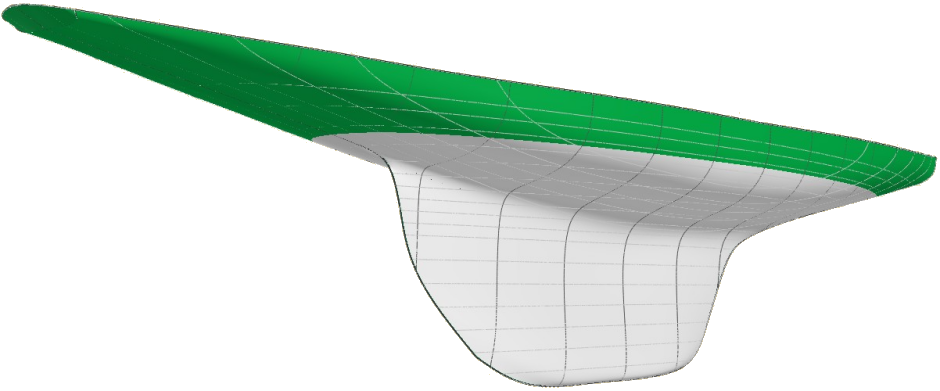Yves GARY Hits: 6155
Category: SHAMROCK II
 Come back of George Lennox Watson
Come back of George Lennox WatsonFor this second boat, which was named Shamrock II, Lipton went to George Lennox Watson for the design. Watson was probably the foremost designer in England at that time, if that adjective can be applied to any one man in a profession. His cutter Britannia was one of the most wonderful racing yachts ever turned out.
He was also the designer of the little Madge, and of the America's Cup challengers Thistle and the two Valkyrie. He had thus had ample experience in American waters.
 Before building the new boat, he conducted an exhaustive series of tank experiments with small models to try out various forms. It is believed that this is the first time this had been done with sailing models, though it was quite common with those of steam vessels, the angles of heel and courses when on the wind forming elements that complicated the problem for sailing models. However, Watson put much faith in these tests.
Before building the new boat, he conducted an exhaustive series of tank experiments with small models to try out various forms. It is believed that this is the first time this had been done with sailing models, though it was quite common with those of steam vessels, the angles of heel and courses when on the wind forming elements that complicated the problem for sailing models. However, Watson put much faith in these tests.
No expense was to be spared in this second Shamrock, and again lightness of construction with the least possible displacement, or "body," was sought. The boat was plated with a new alloy called immadium, light but strong, and though the yacht was broken up after two years this material appears to have lasted satisfactorily, despite rumors to the contrary.
In shape, Shamrock II, was an extremely flat boat with long ends (she was almost ten feet longer overall than her predecessor), full water lines, and a deep, narrow fin drawing twenty feet of water. When she was measured her general dimensions were found to be: length over all 137 feet, water line 89 feet 3 inches, beam 24 feet, and draft 20 feet, while Watson tacked on some 600 feet to the first Shamrock's already large sail area and gave the new boat 14,027 square feet. She was, up to that time, the most extreme type of racing machine, though she was to be outdone two years later, as we shall presently see.
|
|
|||||||||||||||||||||||||||||||||||||||||||||||||||
 When on August 14th, Shamrock II was docked American yachtsmen had an opportunity to form at first-hand an intelligent opinion of the appearance of a much-heralded, much-praised and much-condemned yacht. They naturally compared her to American boats. To the eye her body-lines appeared similar to those of Columbia and Constitution, although her ends were longer, her counter and stern finer, and her bow lower, with the fullness carried farther forward, and with more of a "snub" in the turn of the stem.
When on August 14th, Shamrock II was docked American yachtsmen had an opportunity to form at first-hand an intelligent opinion of the appearance of a much-heralded, much-praised and much-condemned yacht. They naturally compared her to American boats. To the eye her body-lines appeared similar to those of Columbia and Constitution, although her ends were longer, her counter and stern finer, and her bow lower, with the fullness carried farther forward, and with more of a "snub" in the turn of the stem.
Her lateral plane seemed not to be cut away so much as that of the Herreshoff yachts, while her bilge was somewhat fuller. In profile forward she appeared to favor the “scow" type, but from other points of view she was more like the so-called normal type of modern bronze yacht, with fair, full body, and very fine fore-and-aft lines. The shape of the bow was her most striking feature.
While one visual expert saw all the qualities of speed in her, others said she had too many curves to prove a winner.
|
An example of a conscientious American opinion of the yacht's qualities, from a critic who saw her in dock, may be had in the following from The Scientific American:
"Watson has returned somewhat to the midsection which distinguished his two most successful boats, Queen Mab and Britannia. There is not the slightest suggestion of the high bilges of the scow form, as seen in Independence, nor is there the comparative hardening of the bilges, as seen in Columbia. So easy, indeed, are the bilges that we have to go back to Defender to find their like, and they round into the broad sweep of the freeboard curve at the fin with a true reverse curve, without so much as a suggestion of a straight line in the floor. These features, taken with the rather full and round sections toward the bow, the finely-drawn-out run and quarters, and the easy curve and great length of the diagonals, point toward a form that will be easy to drive at the higher speeds, and will show but little of that wave-making tendency which was a marked fault in Valkyrie III and Shamrock I. We venture to say that the model of the boat will commend itself at the very first glance to any naval constructor who may chance to see the Shamrock in dry-dock. While the body of the boat would suggest great speed in fresh winds, particularly in running and reaching, we think that she will not prove to be relatively so speedy in light airs." |
The deduction arrived at by this writer fairly represented the careful American estimate of the boat at the time; yet the races showed it was not correct.
 Extreme care seemed to have been taken by Shamrock's designer to make the boat's lines fair to a hair's breadth, and to give her an easy form. She showed his work at the testing-tank quite plainly, and was indeed a beautiful example of what might be called clever designing. In the biggest secret, eleven different models in wax were tested, subject to sixty different modifications, leading to the design of Shamrock II.
Extreme care seemed to have been taken by Shamrock's designer to make the boat's lines fair to a hair's breadth, and to give her an easy form. She showed his work at the testing-tank quite plainly, and was indeed a beautiful example of what might be called clever designing. In the biggest secret, eleven different models in wax were tested, subject to sixty different modifications, leading to the design of Shamrock II.
Sir Thomas had this to say to a Glasgow interviewer apropos the tests made by Mr. Watson, and the results achieved by him in his designing of the yacht :
« Mr. Watson required a great deal of persuasion before he would take in hand the building of a challenger, and I believe all the money that could have been offered to him would not have been sufficient to induce him to undertake the work had it not been that he saw what he considered good prospect of success. This much I can say with certainty, and without betraying any confidences — that in Shamrock II we shall have a yacht totally unlike in shape anything ever launched on either side of the Atlantic, and Mr. Watson is not the man to go rashly experimenting before he found his way clear and giving promise of success. In connection with the designing of this boat he has made discoveries of the utmost importance, and likely to have a very important effect on the future of yacht-designing. »

Plan created with DELFTSHIP

Download the MODEL FOR DELFTSHIP : Hull only
Download the MODEL FOR DELFTSHIP : Full model

